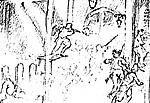When looking at the battle of Aspern, it is important to note that both sides fought very well and that there were a number of factors contributing to the Austrian failure to destroy the bridgehead. But, as in any battle there are some units that distinguish themselves through their actions and gain a measure of fame or notoriety. Aspern would prove to be no exception.
The Austrians: Individually brave, the Austrians suffered from poor tactical coordination and overly-complicated battle plans. The morale of the army was average according to Bowden's Armies on the Danube 1809, and most units were at least well trained, if not combat experienced. Some of the more notable Austrian units at the battle of Aspern:
- The battalions of Brigade Nordmann--Attempting to use skirmisher tactics and infiltrate their way through the marsh along the Danube River to reach the crossing site, their performance was generally poor and according to Arnold, underscored Austria's continuing failure to field an effective light infantry force.
- 60th Infantry Regiment--This unit actually occupied Aspern early in the battle, having driven the surprised French advanced companies from the village. Molitor's counter-attack drove the 60th out after a bitter fight in which the regiment suffered 700 casualties.
- 47th Infantry Regiment--These men finally drove Molitor's stubborn defenders out of Aspern, particularly distinguishing themselves in the hand-to-hand fighting there.
The French: This was not the Grande Armee of 1805-1807. However, the troops at Aspern were battle-hardened, well-led at a tactical level, and their morale was high.
Historical Analysis
Part I: Flirting With Disaster More About Aspern
This article appears in MagWeb (Magazine Web) on the Internet World Wide Web. At right, another Keith Rocco sketch, this of the defense of the church. © Keith Rocco.
At right, another Keith Rocco sketch, this of the defense of the church. © Keith Rocco.
Part II: The Battle for Aspern Begins
Part III: Austrian General Assault
Scenario: French Defense of Aspern Order of Battle (text only--fast)
Scenario: French Defense of Aspern Order of Battle (graphics--very, very slow). Do not attempt to download unless you are on an ISDN or T-1 line.
Map: French Defense of Aspern
Diorama: French Defense of Aspern: photos of museum-quality diorama of the attack (slow).
Back to Table of Contents -- Napoleon #3
© Copyright 1996 by Emperor's Press.
The full text and graphics from other military history magazines and gaming magazines are available at http://www.magweb.com